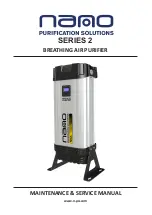
Wiring penetrating hole
Power supply wiring/earth
wiring or remote controller
wiring/transmission wiring
Sealing material
(Small) (13)
(accessory)
Putty or insulation
(field supply)
Fig. 24
<<Mending method of wiring penetrating hole>>
•
After wiring connection is finished, to prevent the penetration
of water, small animals and insects into the indoor unit
from the outside, mend the respective covers for wiring
penetrating hole for the power supply wiring/earth wiring and
the remote controller wiring/transmission wiring.
•
Cut the sealing material (Small) (13) into two pieces and
wrap each wiring with each piece.
•
Seal the clearance around the wirings with putty and
insulating material (field supply).
(If insects and small animals get into the indoor unit, short
circuiting may occur inside the control box.)
•
Keep the distance of 50 mm or more between the low voltage
wiring (remote controller wiring, transmission wiring) and
the high voltage wiring (power supply wiring, earth wiring)
at anywhere outside the indoor unit. If both the wirings are
laid down together, they may be affected by electric noise
(outside noise) and cause malfunction or failure.
8-5 EXAMPLE OF WIRING
< No. 1 system: When 1 remote controller is used for 1
indoor unit. >
Indoor unit A
Indoor unit B
Most
downstream
Indoor unit
Power supply
220-240 V
1~
50 Hz
or
220, 230 V
1~
60 Hz
Power supply
220-240 V
1~
50 Hz
or
220, 230 V
1~
60 Hz
Power supply
220-240 V
1~
50 Hz
or
220, 230 V
1~
60 Hz
Outdoor
unit
L N
F2
N
IN/D OUT/D
F1 F1
L
F2
N
L
Remote
controller
(option)
Remote
controller
(option)
Remote
controller
(option)
L N
L N
L N
P1 P2 F1 F2 T1 T2
P1 P2
P1 P2 F1 F2 T1 T2
P1 P2
P1 P2 F1 F2 T1 T2
P1 P2
< No. 2 system: When carrying out group control or 2
remote controller control. >
Outdoor
unit
Indoor
unit A
Indoor
unit B
Most down-
stream
indoor unit
For use with 2
remote controllers
Case of group
control
L N
P1 P2 F1 F2 T1 T2
P1 P2 F1 F2 T1 T2
P1 P2
Remote
controller
Remote
controller
(option)
Remote
controller
N
L
N
L
F2
F1
F2
F1
N
L
IN/D OUT/D
(option)
Power supply
220-240 V
1~
50 Hz
or
220, 230 V
1~
60 Hz
P1 P2 F1 F2 T1 T2
P1 P2
P1 P2
Note) It is not needed to set the
indoor unit address when
using group control.
(It is automatically set when
the power is turned on.)
< No. 3 system: When BS unit is used >
Outdoor unit
BS unit
L N
Indoor unit A
Remote controller
(option)
F2
F1
F2
F1
F2
F1
F2
F1
IN/D
IN/D
OUT/D
OUT/D
N
L
Power supply
220-240 V
1~
50 Hz
or
220, 230 V
1~
60 Hz
P1 P2
P1 P2 F1 F2 T1 T2
NOTE
1. Remote controller wiring and transmission wiring have no
polarity.
WARNING
Be sure to install an earth leakage breaker.
Failure to do so may cause electric shocks and a fire.
8-6 FOR CONTROL WITH 2 REMOTE CONTROL-
LERS (TO CONTROL 1 INDOOR UNIT WITH 2
REMOTE CONTROLLERS)
•
For control with 2 remote controllers, set one remote
controller as Main and the other remote controller as Sub.
< Changeover method from Main to Sub and vice versa >
Refer to the installation manual attached to the remote
controller.
< Wiring method >
(1) Remove the control box lid.
(2) Carry out additional wiring from the remote controller
2 (Sub) to the terminals (P1, P2) for remote controller
wiring on the terminal block (X1M) in the control box.
3P335596-2D English
14






































